|
If you are kayak fishing or just paddling in water that is less than 70F, this video provides some very important information you need to know. Everyone needs to completely understand how to deal with the elements when out on big open water but knowing cold water safety is the first to learn. Any kayak anglers who spring or fall fish, especially on the Great Lakes, this is a MUST SEE!
If swimming in cooler water makes you uncomfortable, then imagine how ice cold water feels right against your skin in the spring because you chose waders over a proper drysuit.
Jeff Wall | Nomad Adventures info@nomadac.com This article is intended to provide basic information to anyone wishing to take advantage of the spring Great Lakes Steelhead fishery. Although we are targeting migratory rainbow trout, there are many incidental catches that fill our day with joy and help us learn tactics for catching other species we may encounter. Rainbow Trout (Oncorhynchus mykiss) is a species of salmonid which is native to the cold water tributaries of Pacific Asia and North America. Steelhead is an anadromous(sea-run), or in this case, lake-run form of Coastal Rainbow Trout(Oncorhynchus mykiss Irideus) that have been introduced to Great Lakes tributaries. These fish spend their first 1-2 years in the tributaries, then enter the Great Lakes, to later migrate back to their natal streams when they reach spawning maturity. Primary spawning runs occur in the Great Lakes tributaries from late March to late May depending on the winter. Season and HabitatTiming as they say is everything. Especially on a sunny, warm spring day where the lake hasn't been stirred up much. If the water is clear and sun is high, then I'm already off the water looking at my pictures of the day's catch. A light wind is not a bad thing either provided it is in your favour. I prefer to fish a small chop when fishing steelhead and other minnow eaters. It displaces the baitfish more and allows for a wider, deeper zone to troll through. Fishing can be equally as good in the last two hours of daylight too. Finding a lightly wind blown warm shoreline near a creek or river can give whole new perspective on Great Lakes kayak fishing if you time it right! A spot where the sun has warmed all day long with a decent outflow nearby will start to get a trickle of minnows just before dusk that can provide fast and furious action as the sun disappears. Most of the time you are fishing less than 20' of water. Fish are shallow as 5' when the sun comes up and usually stay in less than 20' until then light starts to really penetrate then water. Try to find temperature gradients close to a mud line as they are your best indicator of where to start fishing. The transitioning water colour from brown to green is the area you want to focus on the most. This is where the bait are hanging out to avoid being in plain sight. Zig-zag trolling in and out of the mud line will surely get you bit. This is the season where kayaks have a real advantage over motorboats because of the relatively silent trolling capability. There is no need to run inline planer boards unless you do it to clear other rods when trolling multiple. If you have a leg propelled kayak like a Hobie Mirage series then things are even that much more simplified with hands free fishing. We primarily target spring Steelhead before they enter the tributaries to go about their reproductive business. Anytime that conditions allow and you feel you are capable of dealing with them is the right time to go. This article is not about safety so if you feel there may be a risk and are not comfortable with it, then do not go. Steelhead begin entering Great Lakes rivers in October and can still be around in early June. Spring runs are more consistent from April to mid May. Once they are safely higher up in the system, it is our practice to give them free passage. Although we are not afraid to go and pound on a fresh run of fish near the lower stretches of rivers, we prefer letting those who passed the gauntlet, to carry on and make lots of future angling opportunities. Especially on rivers that yield wild fish! Locating and Timing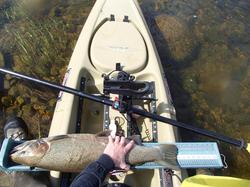 The old spawned out warrior in this picture is a catch we try to avoid but can't always when targeting migrating fish around rivers. For this reason we tend to concentrate our efforts in the lake near the river, rather than in it. He took about 5 mins to revive even in icy cold water. A chrome bright fish in the spring does not mean it is a fresh arrival! Many steelhead finish their spawning ritual before the river season opens, and they are almost fully healed from their wounds, leaving them with their beautiful silver sheen. These kelts are the most sensitive of the lot. They are extremely hungry and feed ravenously on anything they can find. They are also very susceptible to death if hooked and and fought to exhaustion with less oxygen in the warming rivers. They cannot recover since they have no reserve body mass to fall back on. Please do not target these fish! 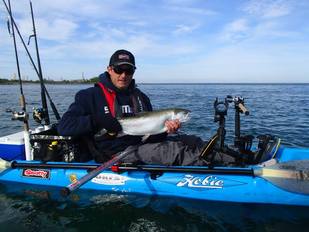 This spring hen was caught in Lake Huron near a major tributary. She was fully recovered from spawning and caught June 1 gorging herself on shiners when she hit a Live Target Rainbow Smelt. Anything resembling a shiner or smelt style minnow and fished near a river outlet on the Great Lakes will get bit... by something. It will most likely be a steelhead, coho salmon, or brown trout but could be any number of other species following the bait. Move around in the lake until you mark bait or spot it. Glenn Coin | gcoin@syracuse.com
on February 18, 2015 at 4:29 PM, updated February 19, 2015 at 10:13 AM Update: The ice continues to cover more of Lake Ontario each day. The latest report shows that the lake was 82.6 percent covered as of Wednesday. Syracuse, N.Y. -- The amount of ice covering Lake Ontario has reached near-record levels, and scientists say that's the result of two cold winters in a row. One result of all the ice is that Central and Northern New York are getting less lake effect snow than they would otherwise. Extensive ice cover reduces evaporation, the raw ingredient for lake effect snow. On Tuesday, ice covered 78.5 percent of the surface area of Lake Ontario. That comes close to the record of 85.7 percent, set on Feb. 19, 1979. This much ice is highly unusual on Lake Ontario, which generally has the least ice cover of any of the five Great Lakes. The long-term average for Lake Ontario, in fact, is just 11 percent. Ontario is particularly deep compared to its surface, so it retains heat better than the other lakes and is less likely to freeze. What's happening this year is that the lake never fully warmed up after last year's cold winter and relatively cool summer. Those cooler waters, combined with with a bitterly cold January and February this year, create lots of ice. "The lake lost a lot of heat last year and it never regained it during the summer," explained George Leshkevich, a physical scientist at the Great Lakes Environmental Research Laboratory in Michigan. "We're starting out with cooler water temperatures, and with these cold temps we've been having the lake is just in a condition where it can form substantial ice cover." By Howard Meyerson
GRAND RAPIDS, MI – Atlantic salmon will again be stocked at four Lake Huron locations in 2014. State officials are gearing up for the second round in a five-year experiment to determine if an Atlantic salmon fishery can be created there. Approximately 100,000 yearling Atlantics were planted in the lake during the spring of 2013, but none appeared in the catch so far, according to state fisheries officials. “We expect that all that to start rolling next summer,” said Todd Grischke, the Lake Huron basin coordinator for the Michigan DNR. “A lot can happen between now and then, but we will be evaluating the harvest each of the next two seasons and weaving that information into a long-term plan of where to go. “Next year we are looking at stocking 130,000 yearlings. And, if all goes well, we will look at a 150,000 more in 2015 and stick to the same study design.” Atlantic salmon may help fill the fisheries gap that was created in Lake Huron when Chinook salmon population collapsed in 2003 and 2004. Grischke and others are hopeful that they will fare better being a more opportunistic feeder. Chinook salmon rely on alewives which virtually disappeared. Atlantics are also thought a good compliment to the multi-species fishery that is developing in Lake Huron now. Walleye, steelhead, perch and some Chinooks are all being caught. STOCKING TO INCREASE OVER NEXT TWO YEARS The 2014 plan calls for increasing Atlantic stocking at each of the four locales that got them this year. The St. Mary’s River will get 50,000 yearlings in 2014, up from 35,000. Alpena/Thunder Bay will get 25,000 instead of 20,000, and the Au Sable River will get 35,000, up from 30,000. Lexington will get 20,000 rather than 15,000. “I’m really excited about it,” said Frank Krist, an avid angler from Rogers City and the chairman of the Lake Huron Citizen’s Advisory Committee, a group of anglers convened by the DNR for discussion and review. The group recently reviewed the plan. “The fish stocked this (past) spring will be big enough to be caught in the 2014 spring fishery,” Krist said. “And next fall about 30 to 50 percent of those fish will be mature enough to return to the stocking sites to spawn.” Authors: Parsons, John W.
Publication Year: 1973 Book or Record Title: History of salmon in the Great Lakes, 1850-1970 Extent of Work: 80 Series Title: U. S. Bureau of Sport Fisheries and Wildlife Technical paper no. 68 Abstract: This history of the salmon in the Great Lakes describes the decline and extinction of the Atlantic salmon (Salmo salar) in Lake Ontario in the 1800's; the failure to establish, by salmon culture, permanent or sizable populations of Atlantic or Pacific salmon in any of the Great Lakes in 1867-1965; and the success of the plantings of coho (Oncorhynchus kisutch) and chinook salmon (O. tshawytsha) in the Great Lakes, in 1966-70 -- particularly in Lake Michigan. Despite plantings of 5 million fry and fingerlings from Lake Ontario stocks in 1866-84, the native Atlantic salmon in Lake Ontario became extinct in the late 1800's primarily because tributaries in which they spawned were blocked by mill dams. Plantings of 13 million chinook salmon and landlocked and anadromous forms of Atlantic salmon in Lake Ontario and the other Great Lakes in 1873-1947 failed completely. The first species to develop a self-sustaining population was the pink salmon (O. gorbuscha), which was planted in Lake Superior in 1956; however, it has not become abundant. A salmon fishery finally was established when 15 million coho salmon and 6 million chinook salmon were planted as smolt in the Great Lakes in 1966-70. In 1970, for example, 576, 000 coho salmon (12% of those planted in 1969) were caught by anglers in Lake Michigan. Most weighed 5 to 10 pounds (2.3-4.5 kg). Sport fishing for salmon was fair in Lakes Superior and Huron, and poor in Lakes Erie and Ontario. By 1970, natural reproduction of coho, chinook, pink, and kokanee (O. nerka) salmon had occurred in some tributaries of one or more of the upper three Great Lakes. It is expected, however, that the sport fishery will continue to be supported almost entirely by planted fish. Lake Huron Spring Chinook SalmonJeff Wall | Nomad Adventures info@nomadac.com The groundhog said six more weeks of winter from Feb 2.... he was wrong! It has been a lot of years, close to 20 since I was able to put some decent time in on the spring Great Lakes fishery. April is normally our second busiest month for river guiding, but the winter that wouldn't go away gave us some time for personal fishing. Canadian kayak fishing guide Jeff Wall showcases his spring catch. Over 40 fish caught in six outings last spring. All were salmon or trout except one giant out of season walleye. Steelhead, Coho Salmon, Brown Trout, Chinook Salmon, Atlantic Salmon, Walleye, Lake Trout were all caught and released over six separate days of fishing. Long lining shallow crankbaits on light lines pretty much sums up the spring kayak fishing in Ontario for the Great Lakes region. We employed a variety of minnow baits, smaller spoons, and kwikfish style lures. Slow trolling with abrupt direction changes were the ticket in the open water trolling but crashing two lures thru the baitfish schools got us several doubles. I don't have to tell you how exciting that is in a kayak! Please always consider best practices when heading out on the Great Lakes, especially when it is still winter. Better yet, hire a guide! Be sure to look up Nomad Adventures for your next spring kayak fishing trip. Hope you enjoy! Giant Lake Ontario WalleyeLake Ontario Atlantic SalmonTake the time to read and understand ALL the rules that apply to operating human powered watercraft in Canada. It will probably one day save you some money from being fined, but may well save your life too!
|
FISHING NEWS ONTARIOOntario and Great Lakes region salmon, steelhead, and migratory trout fishing articles, information, news, and reports. Stay up to date on our most recent trips, events, tournaments, and general news on adventure fishing and kayak fishing in Ontario and Canada. Archives
April 2021
Categories
All
Links |

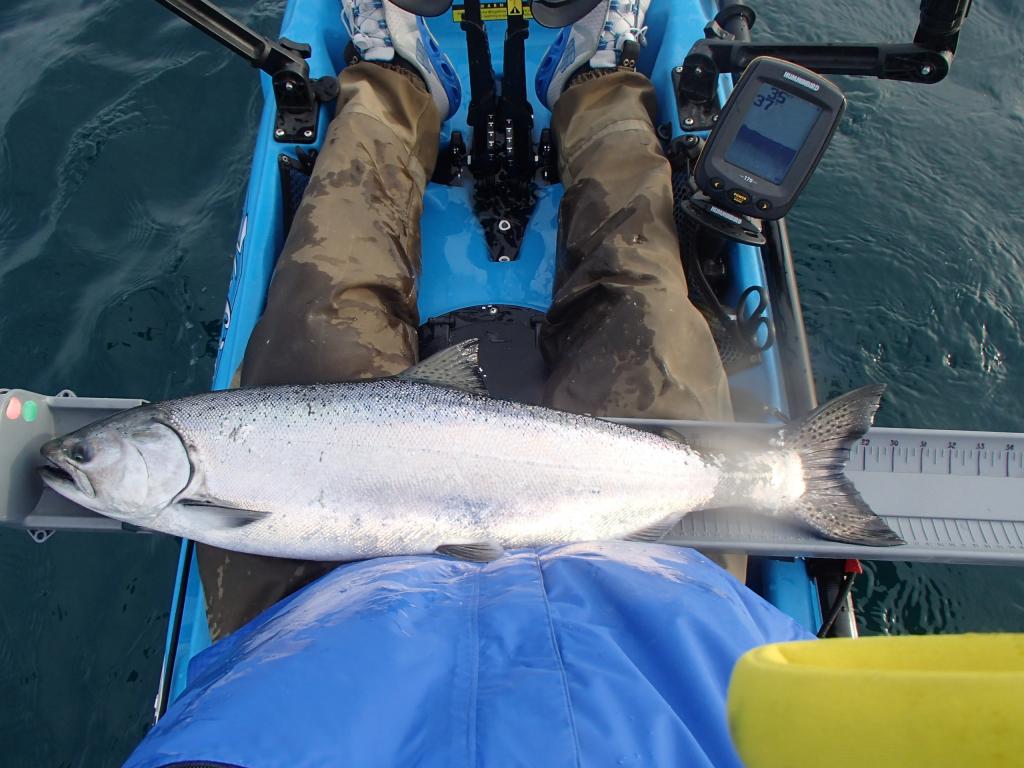
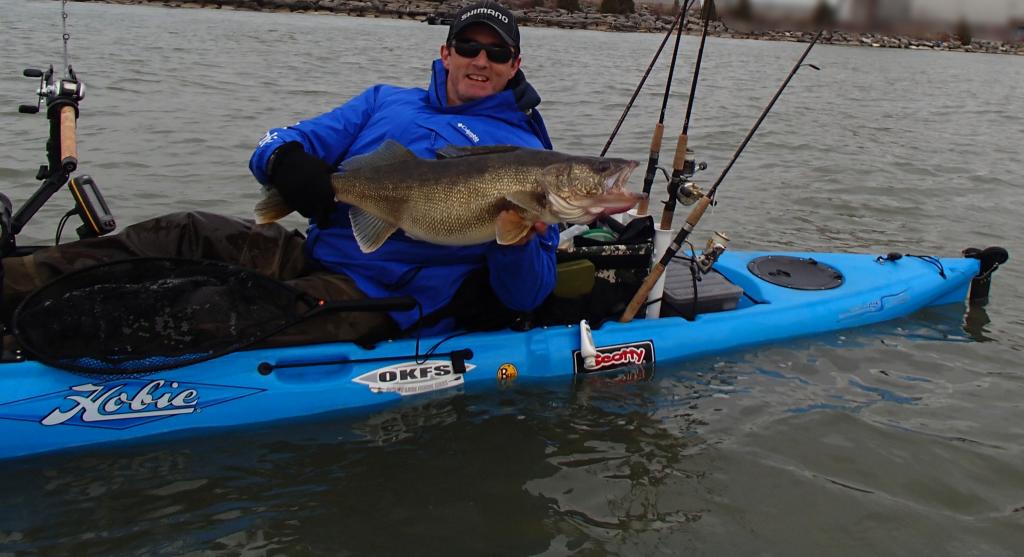

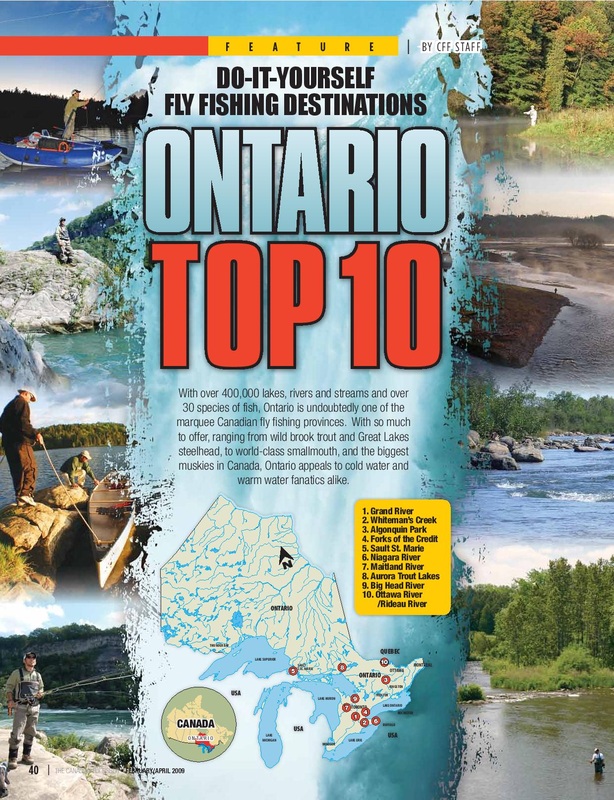


 RSS Feed
RSS Feed